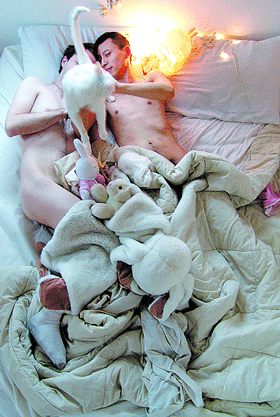Jeffrey Uslip curates a wide-ranging exhibition challenging queer neo-conservatism
An artistic response to the Bush administration’s policy of gay oppression is on exhibit at Artists Space, focusing specifically on the impact of the emergence of a neo-conservative agenda within the queer community. This large group show with more than 60 pieces from 33 artists, titled “Log Cabin,” alluding to the gay Republican club, serves as a vehicle for a cacophony of viewpoints.
“Log Cabin,” which according to the gallery press release, examines the “lack of an organized body politic,” illustrates both the strengths and weakness of Jeffrey Uslip’s pluralistic curatorial approach. The motions on view shift from desire to absence to sympathy; vengeance is replaced by caustic humor.
AA Bronson’s photo series “Nest,” 2003, presents couples and individuals in their beds from an overhead view, making the most intimate of environments visible. In contrast, in Terence Koh’s “29 Seconds of Attraction,” 2004, a series of photos with the faces painted out in chocolate speaks to the Internet age of dating anonymity.
The video pieces overwhelm the more traditional static works, drawing the viewer in seductively with a combination of sound and visual. In Nayland Blake and AA Bronson’s video collaboration, their bearded faces, alternately covered in black and white chocolate, melt in a passionate kiss on the third monitor––a sight both touching and grotesque.
Jonathan Horowitz’s well edited video piece, “It’s Magic/ Acting the Part: The Biographies of Doris Day and Rock Hudson,” 2002, explores celebrity, interconnection and loss with thought-provoking clarity.
A successful merger takes place in Lovett/Codagnone’s piece, “P.P.P. (“Heretical Empiricism”),” 2004. A handmade motorcycle jacket with projected text, a reference to Pasolini, seamlessly combines symbol and message.
Glenn Ligon’s word-filled painting “More Bitch than Me #2,” 2004.is powerful and aggressive with the use of color and text. Erotic but tinged with humor is Mark Verabioff’s “Strawbitch (Muff Mix),” 2005, which changes the dynamic of the codified bathroom space with hard driving music and spoken word.
This show is powerful but oriented toward insiders, people who already know the parameters of the debate; defying easy definition seems to be the point.
Tolerance is generous but unity is easier to articulate. How do we find the balance? In a society that stresses freedom and human rights, while simultaneously denying rights to some, adjustments are in order.
gaycitynews.com



































